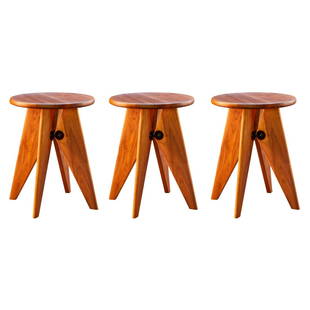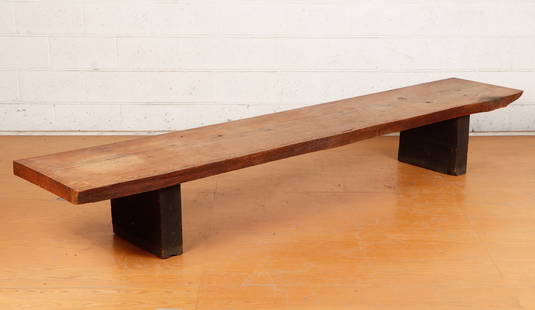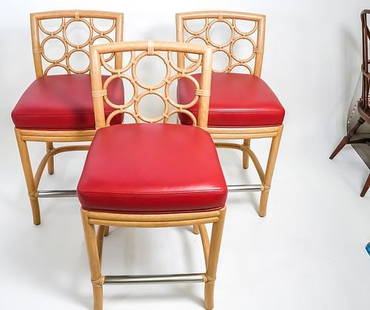
An Andrew Clemens (American, 1857-1894) Sand Bottle
Similar Sale History
View More Items in Benches & Stools
Related Benches & Stools
More Items in American Benches & Stools
View MoreRecommended Furniture
View More








Item Details
Description
An Andrew Clemens (American, 1857-1894) Sand Bottle
Commissioned by John (1859-1939) and Margaret (1860-1931) Leary of McGregor, Iowa, circa 1887
reading Mr. and Mrs. J. Allen / McGregor, Ia. / 1887.
Height with stopper 8 3/8 inches.
Height without stopper 6 inches.
Diameter 3 inches.
This lot is located in Cincinnati.
Provenance:
Mr. and Mrs. John William (1859-1939) and Margaret Jane Leary Allen (1860-1931);
to their youngest daughter Margaret Allen Kleinschmidt (1896-1977);
to her son Thomas Kleinschmidt (1934–2010);
thence by descent to the present owner.
Exhibition History:
Gary Country Club, Gary, Indiana, 1936.
One side of the bottle features a floral wreath enclosing the names and city of residence of a married couple with the date included below. The other side shows a clipper ship at sea flanked by two sailboats. The central designs on each side are offset by Clemens's characteristic oscillating lines and colorful bands of geometric decoration.
Compositionally, the bottle offered here corresponds most closely with the eighth standard "model" from Clemens's 1892 price list, described as "designs, sailing ship, names and bouquet," which retailed for $4.00 at this full pint size. Clemens created a known bottle nearly identical to the Allen bottle five years later at the request of Martha and William Van Ness of Cass, Michigan. Upon receipt of her bottle, which also features sailing ships and a floral wreath, Martha wrote to Clemens to inquire about his working methods. In reply, on July 15, 1892, Clemens discusses the tools he used and notes that "it takes me 2 days to prepare a jar like yours." The rapidity of his execution speaks to Clemens's ability to render increasingly complex designs in a remarkably brief period, which was likely necessary to meet the growing demand for his "pictured rock sand."
The exact circumstances underpinning John and Margaret Allen's commission of this bottle remain unclear. According to the genealogical record, John William Allen (1859-1939) and Margaret Jane Leary Allen (1860-1931) wed in 1881 in McGregor, Clayton County, Iowa. John was the son of an Irish carriage blacksmith who had immigrated to the United States by 1859, and he, too, practiced the trade. John and Margaret had four children and lived in Clayton County until 1910, but the year 1887 does not appear to bear any particular significance in their lives. By 1920, the Allen family had relocated to Gary, Indiana, where John, together with his son Thomas and brother-in-law Charles M. Leary, founded the city's first dry cleaning firm.
In October of 1936, Charles "Slid" Leary (1877-1948) exhibited the Allen bottle on John's behalf at the Annual Meeting of the Gary Country Club. Newspaper coverage of the event in The Gary Post-Tribune describes the bottle as "one of the rarest 'objects d'art [sic]' ever exhibited in Gary – a pint-size druggist's flash containing vari-colored sands arranged to represent a handsome mural, all enclosed within the bottle." Leary was interviewed by the North Iowa Times a week later, about both the Gary exhibition and his recent suggestion that either McGregor or the state of Iowa should erect a bronze monument commemorating Clemens. As a child in McGregor, Leary sought to emulate Clemens, attempting his own amateur sand bottle creations which he sold to passengers on docked boats or stopped train cars. In his adulthood, Leary appears to have become a leading authority on Clemens's oeuvre, by the 1930s having "given many talks on the famed bottles of colored sand." His wealth of knowledge on the topic apparently came from firsthand experience, as Leary reveals in the article:
"You may be wondering why I am so much interested in this bottle and know so much about it. Allens, you will remember, lived in Andrew [Clemens]'s house just in back of the Clemens house, and I spent a large part of my boy's life with them. I saw Andrew do this work many times. I can remember some of the bottles he worked on."
This period of the Allen family's cohabitation with Clemens likely happened at some point after John and Margaret's marriage in 1881, as U.S. Federal Census records from 1880 indicate that John still lived with his parents at 616 23rd Street. Unfortunately, over 99% of the 1890 U.S. Census was burned in a Commerce Department fire in 1921, and the dearth of extant enumerations from that year does not include McGregor residents. By 1900, six years after Clemens died, the Allens are recorded as living in Ward 3 on Ann Street, which abuts the property on Main Street where the Clemens family lived by 1860. Notably, Clemens's father, John (1824-1893), owned the neighboring building, out of which he ran his business, Clemens's Carriage Manufactory. Census records variably list the elder Clemens as both a carriage maker and blacksmith, and an advertisement in the North Iowa Times from 1857 promotes Clemens as a "Carriage and Wagon Maker…All Kinds of Wagons, Ready-Made, on Hand. Blacksmithing and Repairing Neatly Done." As a possible consequence, the Clemens and Allen families connected through the carriage blacksmith trade in McGregor, and from there, through circumstances that we may never fully understand, Andrew Clemens lived with the Allen family, allowing them the invaluable opportunity to bear witness to his masterful creations during the most prolific period of his output.
References:
Sucholeiki, Roy. The Sand Art Bottles of Andrew Clemens. North Carolina: McFarland & Company, Inc., 2015.
"Suggests Memorial for Andrew Clemens: Former McGregorite Offers to Donate to Tablet for 'Sand Artist.'" North Iowa Times, 5 November 1936.
Commissioned by John (1859-1939) and Margaret (1860-1931) Leary of McGregor, Iowa, circa 1887
reading Mr. and Mrs. J. Allen / McGregor, Ia. / 1887.
Height with stopper 8 3/8 inches.
Height without stopper 6 inches.
Diameter 3 inches.
This lot is located in Cincinnati.
Provenance:
Mr. and Mrs. John William (1859-1939) and Margaret Jane Leary Allen (1860-1931);
to their youngest daughter Margaret Allen Kleinschmidt (1896-1977);
to her son Thomas Kleinschmidt (1934–2010);
thence by descent to the present owner.
Exhibition History:
Gary Country Club, Gary, Indiana, 1936.
One side of the bottle features a floral wreath enclosing the names and city of residence of a married couple with the date included below. The other side shows a clipper ship at sea flanked by two sailboats. The central designs on each side are offset by Clemens's characteristic oscillating lines and colorful bands of geometric decoration.
Compositionally, the bottle offered here corresponds most closely with the eighth standard "model" from Clemens's 1892 price list, described as "designs, sailing ship, names and bouquet," which retailed for $4.00 at this full pint size. Clemens created a known bottle nearly identical to the Allen bottle five years later at the request of Martha and William Van Ness of Cass, Michigan. Upon receipt of her bottle, which also features sailing ships and a floral wreath, Martha wrote to Clemens to inquire about his working methods. In reply, on July 15, 1892, Clemens discusses the tools he used and notes that "it takes me 2 days to prepare a jar like yours." The rapidity of his execution speaks to Clemens's ability to render increasingly complex designs in a remarkably brief period, which was likely necessary to meet the growing demand for his "pictured rock sand."
The exact circumstances underpinning John and Margaret Allen's commission of this bottle remain unclear. According to the genealogical record, John William Allen (1859-1939) and Margaret Jane Leary Allen (1860-1931) wed in 1881 in McGregor, Clayton County, Iowa. John was the son of an Irish carriage blacksmith who had immigrated to the United States by 1859, and he, too, practiced the trade. John and Margaret had four children and lived in Clayton County until 1910, but the year 1887 does not appear to bear any particular significance in their lives. By 1920, the Allen family had relocated to Gary, Indiana, where John, together with his son Thomas and brother-in-law Charles M. Leary, founded the city's first dry cleaning firm.
In October of 1936, Charles "Slid" Leary (1877-1948) exhibited the Allen bottle on John's behalf at the Annual Meeting of the Gary Country Club. Newspaper coverage of the event in The Gary Post-Tribune describes the bottle as "one of the rarest 'objects d'art [sic]' ever exhibited in Gary – a pint-size druggist's flash containing vari-colored sands arranged to represent a handsome mural, all enclosed within the bottle." Leary was interviewed by the North Iowa Times a week later, about both the Gary exhibition and his recent suggestion that either McGregor or the state of Iowa should erect a bronze monument commemorating Clemens. As a child in McGregor, Leary sought to emulate Clemens, attempting his own amateur sand bottle creations which he sold to passengers on docked boats or stopped train cars. In his adulthood, Leary appears to have become a leading authority on Clemens's oeuvre, by the 1930s having "given many talks on the famed bottles of colored sand." His wealth of knowledge on the topic apparently came from firsthand experience, as Leary reveals in the article:
"You may be wondering why I am so much interested in this bottle and know so much about it. Allens, you will remember, lived in Andrew [Clemens]'s house just in back of the Clemens house, and I spent a large part of my boy's life with them. I saw Andrew do this work many times. I can remember some of the bottles he worked on."
This period of the Allen family's cohabitation with Clemens likely happened at some point after John and Margaret's marriage in 1881, as U.S. Federal Census records from 1880 indicate that John still lived with his parents at 616 23rd Street. Unfortunately, over 99% of the 1890 U.S. Census was burned in a Commerce Department fire in 1921, and the dearth of extant enumerations from that year does not include McGregor residents. By 1900, six years after Clemens died, the Allens are recorded as living in Ward 3 on Ann Street, which abuts the property on Main Street where the Clemens family lived by 1860. Notably, Clemens's father, John (1824-1893), owned the neighboring building, out of which he ran his business, Clemens's Carriage Manufactory. Census records variably list the elder Clemens as both a carriage maker and blacksmith, and an advertisement in the North Iowa Times from 1857 promotes Clemens as a "Carriage and Wagon Maker…All Kinds of Wagons, Ready-Made, on Hand. Blacksmithing and Repairing Neatly Done." As a possible consequence, the Clemens and Allen families connected through the carriage blacksmith trade in McGregor, and from there, through circumstances that we may never fully understand, Andrew Clemens lived with the Allen family, allowing them the invaluable opportunity to bear witness to his masterful creations during the most prolific period of his output.
References:
Sucholeiki, Roy. The Sand Art Bottles of Andrew Clemens. North Carolina: McFarland & Company, Inc., 2015.
"Suggests Memorial for Andrew Clemens: Former McGregorite Offers to Donate to Tablet for 'Sand Artist.'" North Iowa Times, 5 November 1936.
Buyer's Premium
- 30% up to $1,000,000.00
- 24% up to $5,000,000.00
- 19% above $5,000,000.00
An Andrew Clemens (American, 1857-1894) Sand Bottle
Estimate $60,000 - $80,000
166 bidders are watching this item.
Shipping & Pickup Options
Item located in Cincinnati, OH, usSee Policy for Shipping
Payment

TOP

























































